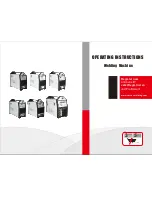
To order parts and supplies: 800.343.9353 >> eastwood.com
17
The Eastwood MIG 180 can be used to form many different joints and welds all of which
will require practice and testing before using on an actual project piece. This following
welding process is just a baseline to get started. Welding, as with any skill, requires a
learning curve to achieve proficiency. An extended period of “Trial and Error” performed
on scrap material is required before welding on an actual project can begin.
• Refer to the ‘Suggested Settings’ chart which is located inside the side door of
the Eastwood Welder. From the chart select the baseline starting point for the
recommended settings described in the chart.
• Connect the ground clamp to the work pieces that are to be welded. Make sure
the ground clamp contacts are placed on a clean piece of metal free of paint,
grease, rust, oils, etc. It is recommended to place your ground clamp as close
to the weld area as possible.
• Assess the general work area and make sure the welding area is also cleaned
of any paint, grease, rust, oils, etc.
• Plug in the Welder and move the Power Switch at the Upper Rear Panel to the “ON” position.
• Set the MIG Gun/Spool Gun Selector located on the Front Panel by pressing the Button to select to the MIG Gun Mode
(FIG 17)
.
• Depress the Welding Gun trigger pointing the welding gun away from your body or anyone else then let go of the trigger and cut the wire back to
~1/4” stick out length.
• Wearing a welding helmet, gloves with long sleeve shirt and pants, put the end of the wire sticking out of the gun into the joint to be welded.
• Position the MIG Gun so that it is perpendicular to the base metal with ~20° tilt back.
• Depress the trigger to start the wire feed which starts the arc.
NOTE:
A push, perpendicular, or drag technique can be used to weld the pieces together; the type used depends on the type of joint as well as other
influential conditions.
- Once the trigger is depressed and the arc has started, a molten puddle will form; this puddle is the weld bead and will follow the motion of the MIG Gun.
- Watching the size of the puddle dictates how the Gun should be moving.
- If the material burns through, the Gun is either moving to slow or some Wire Speed & Arc Volts setting adjustments must be made.
- If the base metal is not being penetrated, the Gun is either moving to slow or some Wire Speed & Arc Volts setting adjustments must be made.
• Release the trigger on the MIG Gun to stop the weld.
• After welding is complete, turn off the Welder and disconnect from power source.
FIG. 17
FIG. 17








































